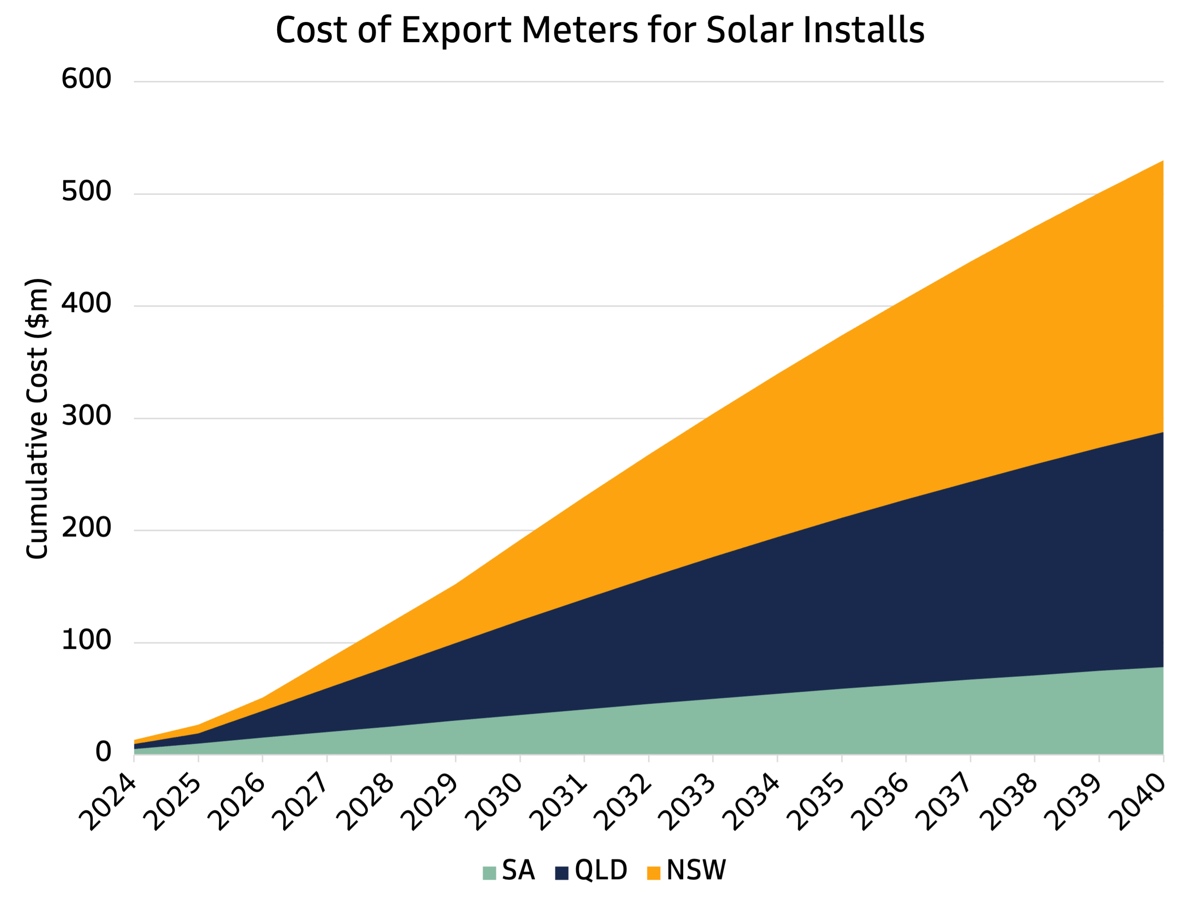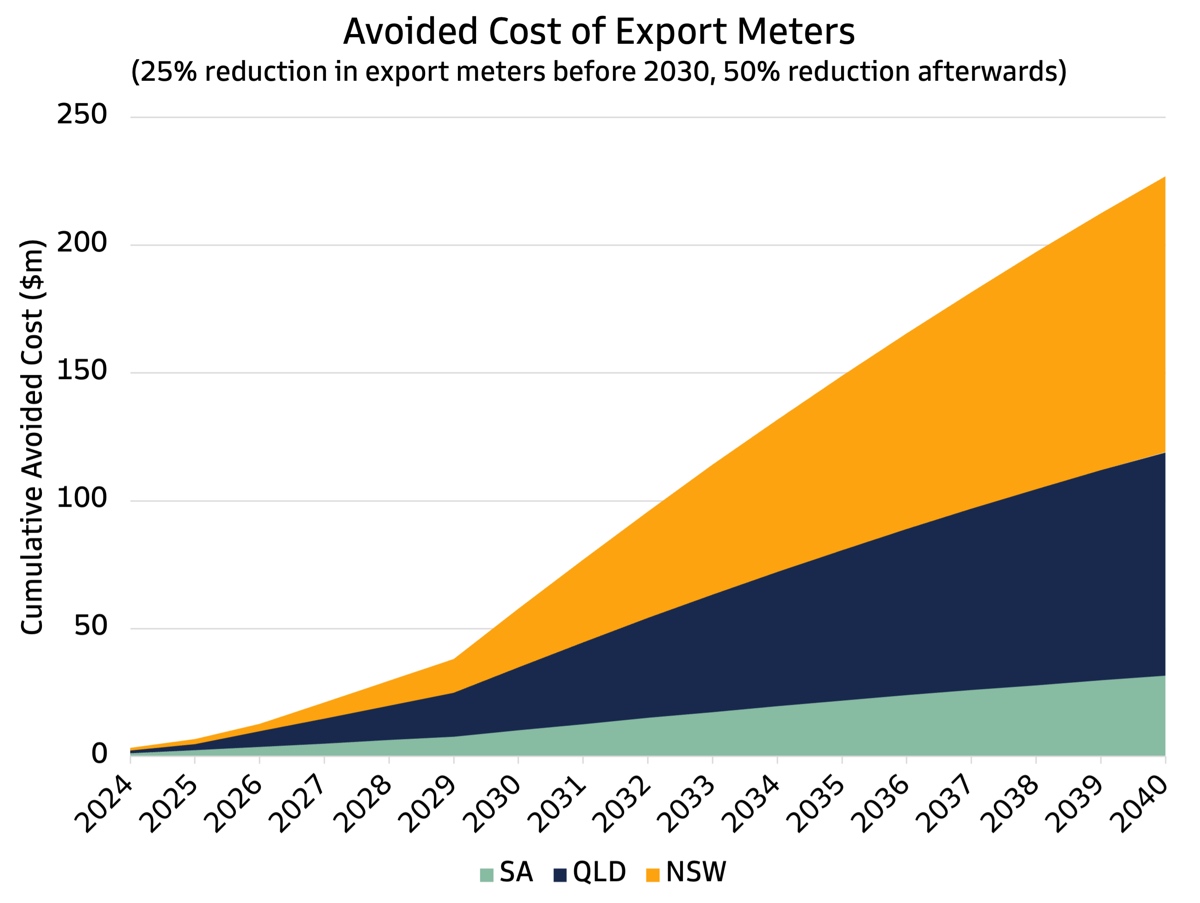
May 17, 2023
When residential energy consumers get a solar system installed the network assigns them an export limit. This is the maximum they’re allowed to export from their house. Often it’s 5kW per phase, although in some areas such as Ausgrid it can be up to 10kW per phase.
If you install a solar system that’s bigger than the export limit, there’s a risk that under low household load scenarios it could generate so much that it breaches the limit. Consider a 7kW inverter installed with a 5kW export limit. In scenarios where it’s generating at its full 7kW and the house load is below 2kW, it will breach the export limit. To eliminate this risk the solar system is required to monitor exports at the residence and reduce its output when it detects that the export limit is being breached.
With the introduction of flexible export limits, which require export monitoring, and the lowering of static export limits, the proportion of new solar systems requiring export monitoring will reach close to 100% before the end of the decade.
How does the solar system do this export monitoring? In almost all scenarios an “export meter” is installed. This is a piece of kit supplied by the inverter manufacturer that is installed at the connection point of the house to monitor energy flows, and sends that data to the solar inverter.
“Why doesn’t the solar inverter just use the smart meter?” you might ask. Great idea! It’s an existing meter that’s already metering the connection point and very often has an external data port that you can plug into. Unfortunately though it’s bureaucratically difficult to attain permissions and training to do this, so that option is rarely used.
As an industry we’re taking a cursory look at removing barriers to allow solar systems and other DER to easily connect to the smart meter, but there’s not a lot of urgency. Grids suspects this is due to not understanding the size of the potential benefits of doing this, and overestimating the difficultly of doing so. So lets take a closer look.
How big might this problem be?
Presumably you’ve read the title so there’ll be no surprises here. But let’s do some simple modelling out to 2040.
We’re going to focus on South Australia, Queensland, and New South Wales as they have a lot of smart meters and solar to install, plus we can reliably expect their export hosting capacity to reduce which leads to introducing flexible export limits and lowering of static limits.
The assumptions are in a footnote[1] and the model is here if you’d like to play around, but to get to the headline results:

In the model the export meters impose half a billion dollars in costs on energy consumers in just these three states out to 2040.
The alternate solution of the smart meter may not be able to be used in some cases, such as an existing smart meter without a local data port or necessary firmware, a smart meter installed in a way where it’s infeasible to access the data port (such as tightly packed into a switch board), or a solar system that doesn’t have a software integration to read the smart meter data feed. In those cases an the export meter will need to be installed. If we conservatively assume that:
We get these type of avoided export meter costs:

The number only goes up if you also consider Victoria, which may be able to use many of their existing smart meters, and add batteries and V2G chargers to the analysis, which will all require connection point monitoring.
In the AEMC’s metering review they commissioned a cost benefit analysis of accelerating the roll out of smart meters. Benefits modelled were things like a reduced need for manual meter reads and greater uptake of cost reflective tariffs:
As you can see from the scale of the numbers, an extra $200M+ in benefits from ensuring smart meters are “export monitoring compatible” is a material addition to the current total benefits case in smart meter reforms.
What needs to change?
Smart meters are highly regulated as measurements from those devices underpin the integrity of the entire energy system. Because of this there are many rules and requirements around these metering installations.
Solar installers would need to have additional training and meters would need extra hardware and software controls to ensure the security of measurements used for market settlement.
We already allow 3rd parties to read from the meter through the optical port. So much so that the Victorian government subsidises devices that use this optical port to give you real-time energy data on your phone. The idea of having an external data port that anyone can plug into with the customer’s permission to pull real-time energy flows in a similar way to the optical port should be explored. Bonus points if this data port can be accessed in a way that doesn’t compromise the rest of the metering installation, in which case no permissions or remote enabling of the capability from the metering coordinator is required.
There is some confusion from industry around real-time data access from smart meters. People often point to the NER and claim that only certain parties can access data from the meter. This is misunderstanding the terms “energy data” and “metering data”, two things which are heavily regulated within the NER. People intuitively suspect that sampling real-time power flows obviously constitutes energy data or metering data, but if you look at the definition of both those terms they’re referring to 5-minute and 30-minute accumulation measurements used for market settlement. This suggests that real-time instantaneous power flows are more accessible than one might think under the current rules. More details in the footnotes[2].
The reason for bringing this issue up is it seems to be flying a little under the radar. While it’s talked about somewhat in the AEMC’s metering review, it’s being presented as a small add on to the reform that has a lot of tricky barriers, and wouldn’t it just be easier for DER control systems to get (near) real-time meter data from the cloud? (answer: that won’t work at all).
Parties such as SwitchDin, Rheem/CET, the CEC and others have diligently submitted useful information in the need for this local access, but these type of reviews have a huge number of submissions and topics, so details like this can sometimes be hard to pick out through the noise.
Finally, we’re well on the way to rolling out flexible export limits and lowering static export limits. This dramatically increases the amount of systems that will require export monitoring. This is another reform that’s had huge amounts of development on certain topics such as the protocols, DNSP systems and allocation methods, but the idea that this will incur hundreds of millions in extra costs on consumers due to requiring them to install a duplicate meter, and can we avoid some of those costs, seems to have been overlooked a little bit.
Thanks for reading.
Footnotes
[1] Modelling Assumptions
Annual solar installs are roughly based on the latest GEM STC modelling (page 20) out to 2030 with a fixed decline to 2040, which is:
Currently it’s assumed 30% of solar systems in SA and QLD are large enough to require export monitoring, and 20% in NSW (Ausgrid have a 10kW static limit).
The assumed year flexible export limits are introduced:
When flexible export limits (FELs) are introduced we assume 100% of systems require export monitoring, due to the requirement for export monitoring for FELs, and the lower static export limit (SAPN for instance is lowering their static export limit to 1.5kW when FELs are introduced).
The average cost of an export meter is assumed at $300, which is on the conservative side. Wholesale costs for export meters are typically between $150-$450 depending on number of phases, and quality of manufacturer. Here’s a solarchoice article indicating Fronius export meters cost $330-$850 installed.
[2] NEM Metering Interpretations
Often parties will point to clauses in the NER to argue that solar systems can’t connect to smart meters for export monitoring. Clauses such as:
NER 7.15.3(a) “The Metering Coordinator must ensure that energy data held in the metering installation is protected from local access and remote access by suitable password and security controls in accordance with paragraph (c).”
NER 7.15.4(a) “the Metering Coordinator must ensure that access to energy data held in the metering installation is only given to a person and for a purpose that is permitted under the Rules;”
NER 7.15.5 “..only the following persons may access or receive metering data, settlements ready data, NMI Standing Data, and data from the metering register for a metering installation:
Registered Participants… the Meter Coordinator… the Metering Provider… the Metering Data provider… AEMO…”
“energy data” and “metering data” are defined terms in the NER, if we look up their definitions:
“energy data: Interval energy data or accumulated energy data”
Interval and accumulated energy data is 5-minute or 30-minute accumulation data (basically, volumes of energy) used for market settlement.
“metering data: Accumulated metering data, interval metering data, calculated metering data, substituted metering data, estimated metering data and check metering data.”
They sub definitions are also different types of 5-minute and 30-minute accumulated energy measurements used for market settlement.
Now, this is definitely not legal advice, but it seems that the data we’re looking for: samples of instantaneous power from the meter, doesn’t constitute energy data nor metering data, therefore the above NER clauses don’t apply to the data that is required.
So while the NER does heavily protect the reading of accumulation data used for market settlement, just using the meter to understand the instantaneous power seem… for the most part fine?